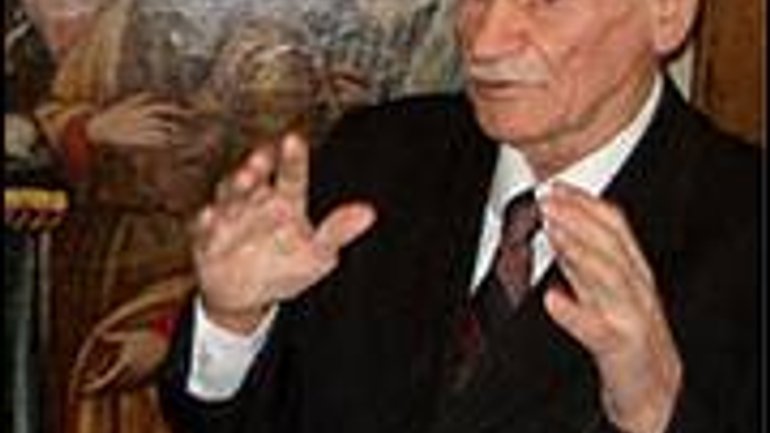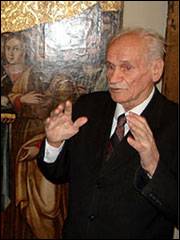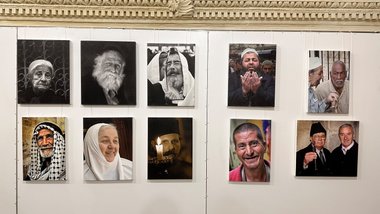“The Ukrainian wooden church has no analogues in European and world art “

 Borys VOZNYTSKYI, director of the Lviv Art Gallery, talks about the fate of Ukraine’s wooden churches.
Borys VOZNYTSKYI, director of the Lviv Art Gallery, talks about the fate of Ukraine’s wooden churches.
Today the theme of preserving Ukraine’s sacred art heritage is on the agenda. The religious culture of people which has been formed for many ages, is gradually being lost for various reasons, including incomprehension of its value in modern society. The exhibition “The Ukrainian wooden church - A pearl of world architecture. On the verge of disappearance,” which opened on 27 November 2008 in the Lviv Art Gallery on Stefanyk Street, 3, draws attention to this problem. Ihor SKLENAR, RISU correspondent, was there and wrote about the particularities of such an important action in the sphere of Ukrainian culture.
The exhibition, which is dedicated to Ukrainian wooden churches, is arranged in three big rooms of this famous art center of Lviv. In the first hall are displayed black and white photos of Volodymyr Olkhomiak. They depict wooden churches which have burned down, mostly in western Ukraine, and are lost once and for ever to Ukrainian culture. As a matter of fact, these photos reflect the peculiar pain of an initiator of this exhibition, the director of the Art Gallery, Borys Voznytskyi, who was engaged in arranging the exposition of the lost churches with the help of his co-workers.
In addition, there is exhibited on a separate table a list of 16 burned churches on the territory of the Lviv Region (the Starosambir, Yavoriv, Sokal, Drohobych, Pustomytiv, and Turkiv districts) and a list of seven churches which were taken down in this region. It is a sad statistic that every visitor can see with his eyes and ascertain the certainly dramatic situation which wooden churches of our area experience. Moreover, displayed on a separate stand are photos of those churches which in time or because of ineffective restoration may also be lost forever for posterity.
Quite another perspective on the vision of Ukrainian wooden churches opens in the neighboring hall. A special feeling arises here that, in spite of losses, we still have considerable acquisitions in our sacred art „arsenal”. approximately 50 models of wooden churches are arranged in long rows in the hall. Their author is a co-worker of the Lviv Museum of Ethnography and Artistic Craft, Mykhaylo Yaskovych, who participated in 15 personal exhibits with the title “Old Ukrainian sacred architecture: Boyko, Hutsul, and Lemko areas.” And some part of the work was accomplished by Mykola Bevz, mainly models of the wooden churches near the Carpathians.
Examining the specimens of wooden churches, you plunge into the world of that epoch when the inhabitants of the mentioned regions of Ukraine appreciated their churches. Churches were centers of spiritual life for them and the common heritage of the community which had built them and transferred from generation to generation the tradition of respect for the church. Strictly speaking, the models enable us to see from nearby unique elements of a wooden church which are difficult to notice while examining a real wooden church. It is necessary to pay tribute to the craftsmanship of the creators of the models mentioned above. Samples of the churches are of different sizes: from very small to bigger, but height does not lessen their religious and cultural originality.
Works of art displayed on the walls of this hall harmoniously supplement the wooden models. A number of exhibited copies of paintings which depict the churches of the Yavoriv District were painted by Volodymyr Patyk – a national artist of Ukraine, laureate of the National State T. H. Shevchenko Prize, honorary citizen of Lviv. His works, which are mostly done in oil paint, radiate simplicity and at the same time a deep vision of the wooden church in its natural setting.
There are works in which it seems as if the church became dark from a gloomy sky, and there are pictures in which they seem to boast of their architecture with great weather. A few copies of paintings look like originals, presented by Evgen and Lesya Bezsnisko, who chose the churches of the Carpathian area as an object of their artistic reflection. Here there is also the conspicuous uniqueness of the style of the famous artist in Ukraine and beyond the borders of Ukraine who, by the way, has many works on biblical themes.
Dozens of photos of a previous director of the National Museum in Krakow, Poland, Adam Bochnak (1899-1974), are presented in two other halls. The basis of these photographs is sacred art monuments from different parts of Poland and separate elements of Roman Catholic churches. It is a particular tribute of memory to a famous artist and at the same time a person who did much to popularize the famous sculptor Joahn Georg Penzel, whom B.Voznytskyi calls “the Slavic Michelangelo.” An impression is formed that these sacred art buildings and their richness, which is represented in the photos of A. Bochnak, denote a peculiar parallel that exists in the cultures of both neighboring nations.
This is a description of the wooden churches exhibit in the Lviv Art Gallery which should interest many appreciators of the religious heritage of Ukraine. We received a wonderful opportunity to reflect on the relevance of the exhibit with a unique person who radiates an adamantine spirit for the preservation of religious and cultural acquisitions. In fact, Borys Voznytskyi, a director with 46 years of experience was that day at work and he willingly agreed to share with the readers of RISU.
RISU note: Borys VOZNYTSKYI, Hero of Ukraine (2005). He was born in 1926. He is a honored worker of culture of Ukraine and Poland, a winner of the Shevchenko Prize and other numerous prizes and decorations of Ukraine and foreign countries. He saved from the destruction thousands of works of art in Soviet times as well as in the recent period. He founded new museum sections; up to the present he popularizes the creative work of such leading figures as J.Pinzel, J.Konzelevych, and others.
- Mr. Voznytskyi, what has brought about this exhibit?
- I will go a little bit into history. The Ukrainian wooden church has no analogues in European and world art. It is solely what is “Ukrainian” in us. If, for example, to look at St. Sophia’s Cathedral in Kyiv, it is something European with the conversion of our architects, where they wished to bring in some of their own Ukrainian traditions. In Soviet times, when we opened the castle in Olesk in 1975, we succeeded in joining a few wooden churches to this museum in order to save them, in particular a church in Pidhirtsi from 1750 [unfortunately, it burned down - I.S.]. In Soviet times many churches were destroyed under the slogan of atheism. In the Lviv Region alone 500 Roman Catholic churches were closed after the departure of Polish people from our lands (only four Roman Catholic churches were opened) and 800 Greek Catholic churches, whose priests refused to join the Russian Orthodox Church. We, employees of museums and artists, were traveling in the 1960s-1970s around the regions and we rescued what we could. We succeeded in collecting and save quite a few unique monuments to the past. Moreover, Galician intelligentsia put the question to themselves: “How can we save this or that church?”The answer consisted in arranging museums there. At that time it was the only way out – to arrange museums of folk art, museums of Easter eggs in churches (in the village children brought some things to the church). It reached the point that some churches were changed into museums of atheism, but we made light of this, because we understood that a church can be saved in such a way. In Soviet times local communists burned down only one church in Husakiv, Mostiska District, Lviv Region. One church was taken apart on the road from Lviv to Kyiv, as if it stood in the way; even then such argument looked senseless.
- It is known that in the period of Ukrainian independence the saving of churches which are monuments of architecture did not acquire such significance. How do you evaluate the present condition of wooden churches?
- Unfortunately, their condition is saddening, because many people were brought up by the Soviet system and they still keep its negative features. Today many people imagine that the renewal of a Ukrainian church means building new churches, in which it is necessary to bring new icons, a new iconostasis painted in a modern manner. We see such a tendency in that the works of prominent Ukrainian artists of the 20th century, Petro Holodnyi and Oleksa Novakivskyi, are thrown out of churches. It turns out that such a unique heritage is becoming strange to our contemporaries. But it is necessary to remember that these artists in the 1930s traveled to the Hutsul area to draw unique churches, in spite of the fact that they were there on the vacation. Today our contemporaries have other artistic tastes, and such modernized conceptions about icons can be found among our priests, certainly I don’t mean all. Therefore, for a part of the Orthodox priests who are graduates of the seminaries in Zagorsk (near Moscow) and Leningrad, the Ukrainian icon is not valuable, it does not mean anything for them. The idea spreads that an old church has to be destroyed or burned.
I remember the Council of Trent from church history (16th century). The Roman Pontiff said that artists took liberties and the artist Michelangelo painted a naked Virgin [Mary] in the Sistine Chapel. The Pope also said something else, that Eastern Catholics pray before icons painted by schismatics, heterodox, and then Lviv Archbishop Sulikovskyy commanded that all icons from the churches be thrown out and burned. Why can nobody say today that it is not allowed to burn icons? According to the Eastern tradition, if we cannot pray before an icon because of its condition (it is blackened or broken), it is necessary to burn it or bury it. This is an approach which still exists. But why has nobody changed it yet? I assume that people burn churches down with such an approach. It is not considered a sin anymore; somebody cites the tradition, so to say, if we don’t pray in this church, let’s burn it down. However, such traditions do not favor the preservation of a unique sacred heritage.
It is painful for me to see the quantity of churches that have burned down in recent years – 158 wooden churches! I recall in this context central and eastern Ukraine in the period of the 1930s: at that time Stalin’s soldiers burned down 15 thousand churches! If to take into consideration that there was one iconostasis in a church and there were no more icons, then the number of icons that were burned is approximately half a million. Now in central or eastern Ukraine there is not one saved icon dating before the 17th century. For example, at exhibits of icons in Kyiv there are exposed specimens from the 15th-16th centuries, painted by Galician artists. In the epoch of atheism, in the 20th century all this ancient heritage was destroyed. And when similar things are going on nowadays, unique churches with icons burn down, all this causes anxiety and concern among art critics. But I think not only they should worry about this, but the church as well.
– What are the ways out of this situation? Drawing society’s attention to this exhibit? Most likely it will be difficult to save wooden churches from eventual destruction.
– I set some hope on the church. Formerly, when I worked in the Commission of Sacred Art at the Lviv Archeparchy of the Ukrainian Greek Catholic Church, the Lviv archbishop at that time, and the present patriarch of the UGCC, Lubomyr (Husar) proposed delivering lectures for priests who head the deaneries, to gather the priests, to go out to the regions and tell them about the value of the sacred art heritage. In my opinion, it is necessary to do this now.
– Does the state make its humble contribution to protecting churches that are monuments of architecture?
– For example, there is a law in Ukraine “On the preservation of monuments,” but its articles can be explained in a different manner: in one way or in another. I wondered, for example, why don’t not call a priest to account for burning down a church, and they tell me he is not responsible for that, his responsibility is to serve liturgies. So to say, he is not responsible for the monuments. “Is the parish council responsible for that?”- I asked. “It is elected and it is not responsible for this as well,” they answered me. It is turned out that today people chose one parish council and tomorrow another. Thus, there is no responsible person in a parish. In Soviet times, when we went from village to village to make an inventory of church property, to register it as a monument of architecture, then the head of the village signed that he was responsible for preservation of a certain church. And today nobody is responsible for this. So laws concerning the protection of sacred art are not developed yet. That’s why we have such a situation.
– Thank you for an interesting conversation and I wish you many years!
... At the exit of the exhibition there hangs a poster made in an artistic style with exhaustive information about the causes of fires of wooden churches and also with data about the quantity of such types of churches in all the regions of Ukraine. It is accentuated here that in Norway there remained dozens of such churches and they are unique in their completion. These churches are called “miracles from antiquity”. So, are we worse than these north European people? The problem of the preservation of the religious culture of Ukraine has many issues, but we must agree with the honored old man that in many cases in our mentality there are present “Soviet remainders.” So let’s overcome these together and then we will not be ashamed before our descendants because of lost masterpieces of architecture, which reflect the religious world-view of our ancestors from ancient times.
RISU’s Ukrainian-language site posted this text on 9 December 2008.










